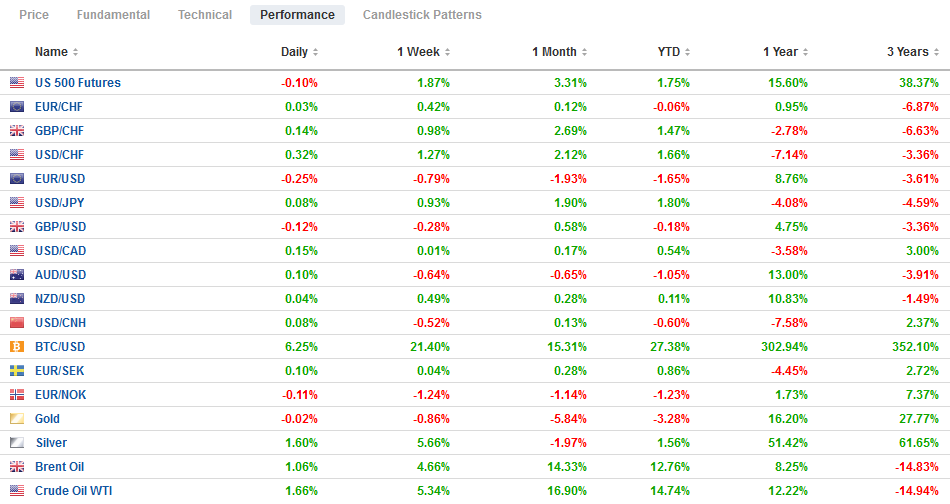Swiss FrancThe Euro has risen by 0.05% to 1.0809 |
EUR/CHF and USD/CHF, February 3(see more posts on EUR/CHF, USD/CHF, )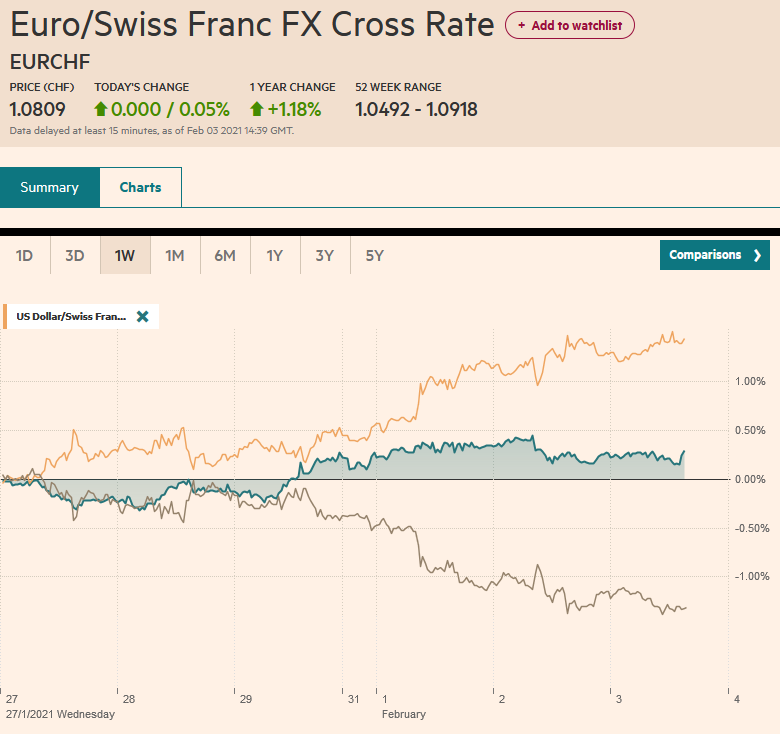 Source: markets.ft.com - Click to enlarge |
FX RatesOverview: Equities have charged higher, and the greenback is mostly firmer. News that Draghi may become Italy’s next Prime Minister has boosted Italian bonds. The PBOC unexpectedly drained liquidity, and this may have deterred buying of Chinese stocks, a notable exception in the regional rally. It stopped last week’s four-day slide with a three-day advance, so far. Europe’s Dow Jones Stoxx 600 gapped higher for the second session and is up about 0.7% in around midday. The S&P 500 gapped higher yesterday and may try to close last week’s gap (~3836.8-3847.8). US Treasury yields are firm ahead of today’s refunding announcement, and the 10-year is around 1.12%. Core European bond yields have edged higher, but the peripheral yields, led by Italy’s nine basis point decline, are softer. The greenback is mostly firmer, though the Antipodeans are resilient in the European morning. The $1.20 level held in the euro on the initial test. Emerging market currencies are mixed, with the central European complex a little softer. The four-day advance in the JP Morgan Emerging Market Currency Index is at risk. Gold is pinned near yesterday’s lows (~$1830). Resistance is seen in the $1845-$1850 area. A further drawdown in US and China oil inventories is helping crude prices consolidate near the recent highs. For the March WTI contract, this means hovering around the $55 a barrel level, the highest in a year. |
FX Performance, February 3 |
| Asia Pacific
Japan’s January services and composite PMI readings were revised slightly higher, but both remain below 50 and weaker than in December (at 46.1 and 47.1, respectively). The composite has not been above 50 since last January. Of note, in the composite, new orders fell to 46.5 from 47.5, and it is the 12th month below 50. The employment component was at its lowest level since last August. |
Japan Services Purchasing Managers' Index (PMI), January 2021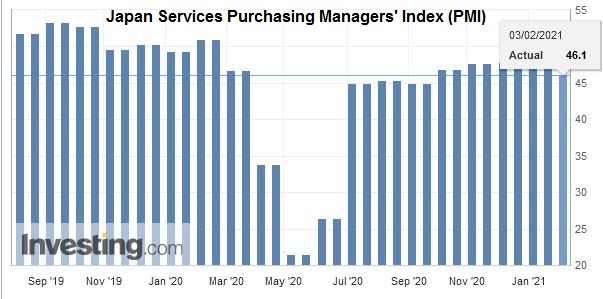 Source: investing.com - Click to enlarge |
| China’s Caixin service and composite PMI were lower than expected at 52 and 52.2, respectively (down from 56.3 and 55.8). This, coupled with the “official” PMI, suggests that the world’s second-largest economy’s recovery is moderating. It is too early to draw policy implications, but looking ahead, next week’s January CPI reading may turn negative, and this could help ease concerns that the PBOC is preparing to hike interest rates. |
China Caixin Services Purchasing Managers Index (PMI), January 2021(see more posts on China Caixin Services PMI, )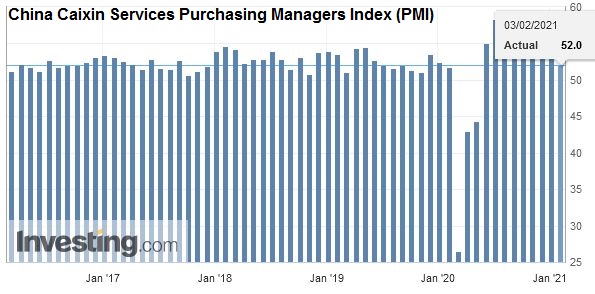 Source: investing.com - Click to enlarge |
Australia’s final PMI was revised slightly lower, but both remain well above 50 at 55.6 for services and 55.9 for the composite. The services PMI is better than December’s 52.0 reading, but the composite is lower than December’s 56.6 report. Tomorrow, Australia reports trade figures, but the impact of China’s “punishment” may continue to be difficult to detect in the aggregate data. RBA Governor Lowe defended the asset purchase program and cautioned against prematurely withdrawing support. He claimed that it has helped lower interest rates and weaken the Australian dollar. Rising house prices are drawing official attention, and it is watching lending standards, which speaks to macroprudential measures if necessary, not rate hike.
The dollar remains firm against the Japanese yen, straddling the JPY105-level in subdued activity. It has been confined to a little less than a fifth of a yen inside yesterday’s range. Its recovery does not look complete, and the next target is in the JPY105.60-JPY105.70 area. Chunky options at JPY105 expire tomorrow and Friday. The Australian dollar traded on both sides of Monday’s range yesterday, but the close was just inside that range. Today it is trading well within yesterday’s nearly a cent range (~$0.7565-$0.7660). It is holding above $0.7600 and appears poised to probe a little higher, perhaps toward $0.7640. The PBOC set the dollar’s reference rate at CNY6.4669, about 10 pips above the Bloomberg survey models. The PBOC drained a net CNY80 bln (~$12 bln) from the banking system as the overnight repo rate fell sharply (-37 bp to 1.86%, a three-week low). An op-ed in the national paper explained that the PBOC is keeping liquidity “tightly balanced” to prevent risks from leveraging. There is expected to be growing demand for liquidity around the holiday period that begins on February 11. Meanwhile, the dollar is trading in very narrow ranges against the yuan as higher lows, and lower highs are being recorded.
Europe
Italy’s Conte ultimately failed to find the support to lead a third government with the existing parliament. President Matterella is seeking to avoid elections during the public health, economic, and social crisis. Moreover, the enacted political reforms would reduce both chambers by a third, and a new division of responsibilities would take some time when the needs of action are so urgent. A technocrat government, like Monti’s in 2011-2013, is the tried and true course. Former Bank of Italy Governor and ECB President Draghi has emerged as the leading candidate.
| The final services and composite PMI from the eurozone were revised slightly higher but not enough to offer much hope that the economy can avoid another quarterly contraction. The service PMI was revised to 45.4 from 45.0, but still off the already depressed 46.4 reading in December. |
Eurozone Services Purchasing Managers Index (PMI), January 2020(see more posts on Eurozone Services PMI, )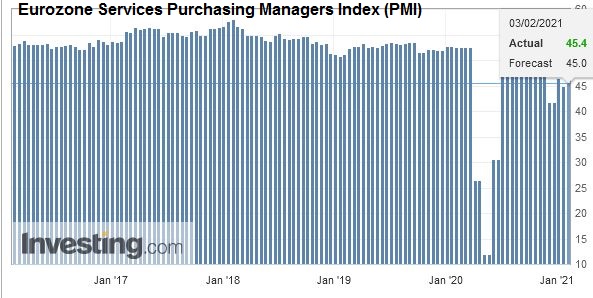 Source: investing.com - Click to enlarge |
| The composite PMI is at 47.8, better than the preliminary estimate of 47.5, yet showing further deterioration after December’s 49.1. It has not been above 50 since last September. German services were tweaked lower, but the composite remained at 50.8 (still down from 52.0 in December). French estimates were revised a little high, but the 47.7 composite (49.5 in December) is worrisome. Italy’s PMI was higher than expected and higher than December at 44.7 and 47.2 (for services and composite, respectively), but the economy is clearly struggling. Spain is the most worrisome. Its service PMI tumbled to 41.7 from 48, and the composite was dragged down to 43.2 from 48.7. |
Eurozone Markit Composite Purchasing Managers Index (PMI), January 2021(see more posts on Eurozone Markit Composite PMI, )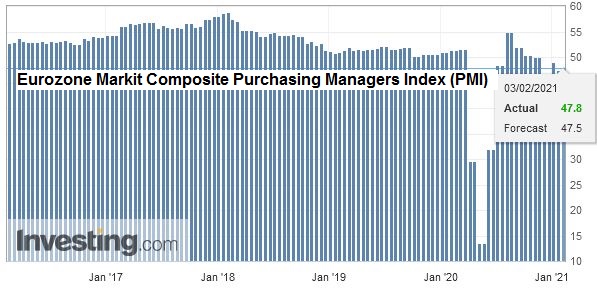 Source: investing.com - Click to enlarge |
| The big surprise of the day was the preliminary eurozone CPI. The headline jumped from -0.3% to 0.9% year-over-year, and the core rate soared to 1.4%, a five-year high, from 0.2%. The surge is about technical factors, like the end of the German VAT holiday, a delay in French seasonal sales, and modifications in the weighted of the CPI basket. What is one to make of it? The takeaway is that inflation is low in the eurozone, but deflation likely overstates the case. |
Eurozone Consumer Price Index (CPI) YoY, January 2021(see more posts on Eurozone Consumer Price Index, )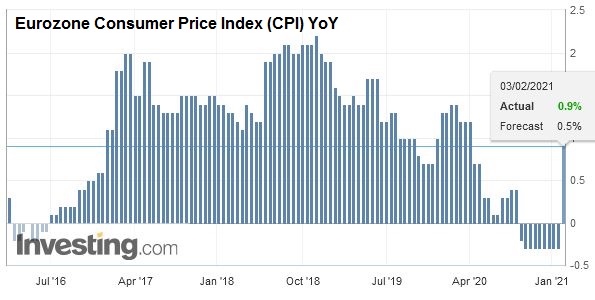 Source: investing.com - Click to enlarge |
The UK final PMI readings were revised higher from the preliminary estimates but remain lower than December and below the 50 boom/bust level. The social restrictions and Brexit disruptions risk a contracting quarter. The services PMI stands at 39.5, up from the 38.8 flash reading but down from December’s 49.4. The composite PMI is at 41.2, better than the 40.6 initial estimate, but below the 50.4 seen in December. The Bank of England meets tomorrow. No change in policy is expected, and the focus is on the forward guidance on negative rates. The BOE is likely to say that while it is a policy tool, they are not ready to deploy it.
The euro set a new two-month low near $1.2010 today in early European turnover. The $1.20 is psychological support, but the next retracement target of the rally since the US election is near $1.1975. Key resistance is seen in the $1.2055-$1.2065 area. For its part, sterling remains within its two-week trading range (~$1.3600-$1.3750), but pressure on the lower-end appears to be building. The cross against the euro has helped sterling’s performance, but the euro’s downside momentum is easing around GBP0.8800, its lowest level since late May. If $1.36 is given, sterling could slide the better part of a cent.
| America
Last month, when the dollar did not sell-off in response to the unexpected loss of jobs in the ADP estimate, it confirmed our suspicions that the bad news had largely been discounted by the decline since the early November election. This time a small gain (~50k) is expected. Bloomberg’s survey’s latest median is for a 70k rise in the January nonfarm payrolls out on Friday. The final PMI and ISM services index are also on tap. The increase in US auto sales reported yesterday to 16.63 mln unit pace (seasonally-adjusted annual rate), the highest since last February, bodes well for retail sales (due February 17). However, the focus is on fiscal policy. There are two elements. First is the quarterly refunding announcement, and it is expected that Treasury will seek to sell $128 bln in coupons next week. Recent auctions have been well-received, and yields at the long-end are near 2-3 week highs. To truly count as a concession ahead of the auction, it needs to sustain the gains through the employment data. Earlier this week, Treasury dramatically cut the anticipated borrowing needs for the quarter to $274 bln from $1.127 trillion anticipated previously on different assumptions about the fiscal stimulus. |
U.S. Services Purchasing Managers Index (PMI), January 2021(see more posts on U.S. Services PMI, )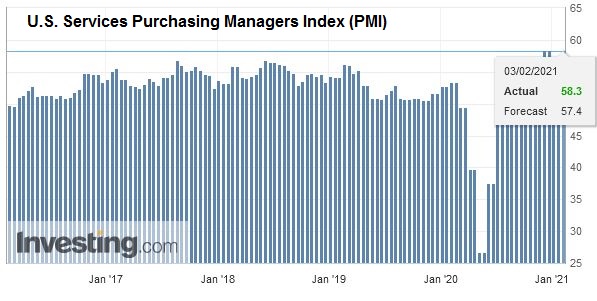 Source: investing.com - Click to enlarge |
The second element is on the negotiations over the $1.9 trillion stimulus President Biden has proposed. While bipartisan talks continue, the Democratic leadership in the Senate is pressing forward with the parliamentary procedure “reconciliation,” which allows it to pass with a simple majority. However, under such a procedure, the stimulus bill will be smaller, and some elements, like the minimum wage increase, will have to be dropped. The alternative proposal includes funds to combat the virus, and it would lower the amount of the “universal income” to $1000 instead of $1400 while tightening income limits. It includes less generous unemployment benefits. The $170 bln Biden proposed for schools was cut to $20 bln. Obama is criticized for “squandering the legislative advantage the Democratic Party enjoyed. At the same time, Biden seems to recognize that his majority gives him little room to maneuver. Moreover, the administration is believed to be preparing to unveil a larger stimulus and infrastructure bill.
The Canadian dollar has been choppy, but it continues to trade within last Friday’s range (~CAD1.2740-CAD1.2875). Rising equities and oil prices support the Canadian dollar, but the firmer greenback more broadly is fostering an extended consolidative phase. The same story more or less held for the Mexican peso, but the dollar briefly slipped through last Friday’s low (~MXN20.0860) in thin turnover as Asia was winding down and Europe was opening. While the greenback recovered, re-establishing a foothold above MXN20.20 may prove difficult.
Graphs and additional information on Swiss Franc by the snbchf team.
Full story here Are you the author? Previous post See more for Next postTags: #USD,Currency Movement,EMU,Featured,Fiscal,Italy,newsletter,PMI









